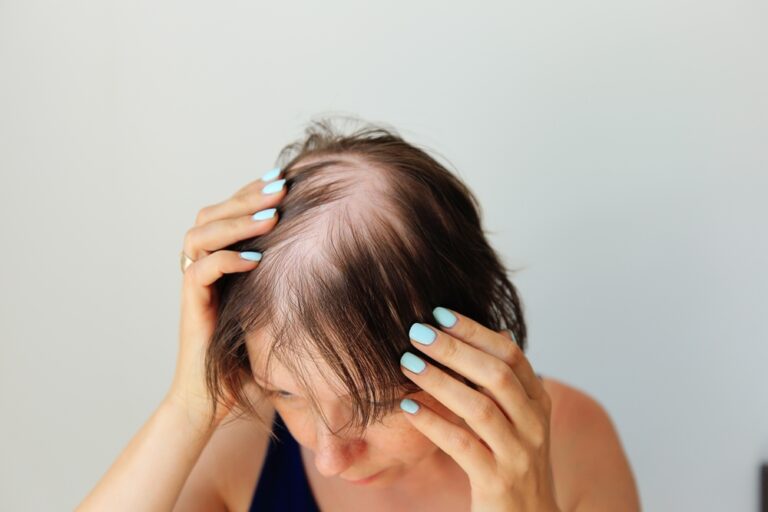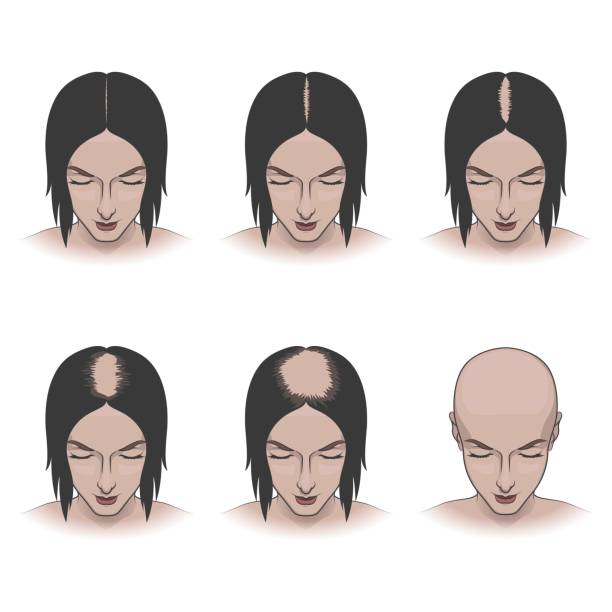DEMYSTIFYING THE KINDS OF ALOPECIA
There are many causes related to hair loss. To apply the right treatment, we first need to know what type of alopecia you have so that we can treat it well.
Our experts are graduates in trichology (hair science) and during a consultation.
Female alopecia is characterized by the overall thinning and diffuse hair all over the skull. From the age of 50, nearly half of women report signs of hair loss. This type of alopecia is usually caused by a hormonal factor. Depending on the stage, we can offer you the right treatment to slow down and strengthen your hair. If necessary, we can install a volumizer.
Male alopecia (androgenic) is easily identifiable by the receding of the front part of the hair and by hair loss on the top of the skull (vertex) or at the temples. Did you know that 80% of men will suffer from baldness before the age of 70? The factors linked to this alopecia are genetics and hormone levels, it can manifest as early as adolescence. When this problem bothers you and decreases your confidence, we can fit you a natural hair piece that will give you back your hair from the past.
Alopecia areata (alopecia areata) is often easily identifiable since it is generally characterized by hair loss in round patches, and randomly on the scalp. This is an autoimmune disease where your immune system attacks the hair follicles in your body, often resulting in hair loss. Alopecia areata in one form or another in 2% of people. It is essential when it occurs not to pull out your fragile and falling hair. A meeting with one of our specialists will allow you to understand the solutions available to you.
Alopecia totalis and universalis are more serious forms than alopecia areata as they cause the loss of all hair and body hair, leading to complete baldness. These are 2 disorders affect only 1% of people with alopecia. The obvious solution is the medical hair prosthesis (wig).
Trichotillomania is a self-inflicted hair breakage and alopecia caused by compulsive twisting and twisting of the hair. It results in broken hair and patches of thinning hair. This type of hair loss should be treated together with the help of one of our specialists and a change in behavior or habits and treatment to strengthen your hair.
Scarring alopecia is one of a large group of diseases that can lead to permanent loss of hair or body hair; it usually affects the scalp. These diseases are present in about 3% of people suffering from hair loss and they lead to permanent disappearance of hair follicles which are replaced by scar tissue. These alopecia are usually diagnosed by a skin sample (biopsy) and require follow-up with a dermatologist. In most cases of scarred alopecia, hair regrowth is not possible. The goal of treatment is rather to prevent the progression of the disease and to replace the hair with a hair prosthesis (wig).
Our experts can assess you and offer you the right treatment. If you start to notice abnormal hair loss, you need to act as soon as possible before it is too late. It is essential to minimize the damage because it is often very long before having an appointment with a dermatologist.
The right behaviors to adopt to reduce hair loss:
–Avoid wearing caps or tight hats;
–Use a mild shampoo with a slightly acidic pH and adapted to your condition;
–Do not space out the shampoos too much to keep a clean scalp so that it can breathe;
–Massage the scalp with a suitable lotion in order to activate the microcirculation;
–Limit the use of harmful styling products that are insoluble in water;
–Avoid playing with your hair or making your hair too tight.
Here are some solutions that can help you with hair loss (from the least invasive to the most invasive):
–Adoption of healthy lifestyle habits, limit stress;
–Use of hair loss shampoo;
–Hair exfoliation in clinic;
–Treatment to increase hair density in the clinic;
–Treatment with topical lotions prescribed according to the type of hair loss;
–Treatments for trichology (hair science) sometimes with laser or infrared light;
–Wearing a volumizer to camouflage lost hair (partial hair loss);
–Wearing a wig when the loss is too great for wearing a volumizer/topper (complete or almost complete loss of hair).





